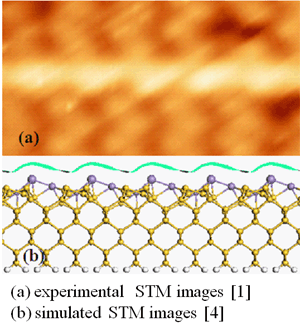There has been considerable interest in recent years in manganese and manganese silicide as promising candidates for spintronics applications. In particular, the study of the initial stages of the growth of Mn on Si(001) is most important in the context of the possibility to fabricate magnetic heterostructures of Mn-Si and related compounds by molecular-beam epitaxy. Scanning tunneling microscopy (STM) studies [1] reveal that room temperature deposition leads to preferential formation of monoatomic Mn wires in early stages, and small clusters appear at higher coverage and compete with the wire growth. Previous theoretical studies on the growth mechanism of Mn on Si(001) [2] and Ge(001) [3] have mainly focused on the surface diffusion of a single Mn atom. The more complicated and important atomistic nucleation processes in the early stages of Mn nanostructure formation on Si(001) remain largely unexplored.
 |
In present work [4], using first-principles calculations, we unveil an atomistic nucleation process of monoatomic Mn nanowire self-assembly on Si(001). We find that Mn adatoms form magic 3n+1 atom dense trimerlike linear chains (DTLCs see the figure) driven by pedestal site adsorption. Moreover, the length of DTLCs is limited by a competing process to form three-dimensional D3h-Mn5 clusters in early stages. These results establish a new structural model distinct from the dimerlike linear chains for III and IV group elements on Si(001) and provide a natural explanation for recent experimental observations.
*Electronic address:
wjt@aphy.iphy.ac.cn[1] H. Liu and P. Reinke, Surf. Sci. 602, 986 (2008)
[2] H. Wu, P. Kratzer, and M. Scheffler, Phys. Rev. Lett. 98, 117202 (2007).
[3] W. Zhu, H. H. Weitering, E. G. Wang, E. Kaxiras, and Z. Zhang, Phys. Rev. Lett. 93, 126102 (2004).
[4] J. T. Wang, C. F. Chen, E. G. Wang, and Y. Kawazoe, Phys Rev Lett 105, 116102 (2010).


